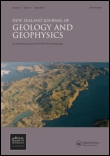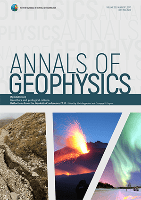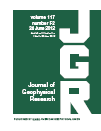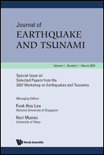
Acta Geophysica
Scope & Guideline
Exploring Earth's Secrets, One Study at a Time.
Introduction
Aims and Scopes
- Geophysical Methods and Applications:
The journal covers a broad spectrum of geophysical methods, including seismic, electrical, magnetic, and electromagnetic techniques, focusing on their applications in subsurface exploration, environmental monitoring, and resource management. - Climate and Environmental Studies:
Research addressing the impacts of climate change and environmental factors on geophysical processes is a core focus. This includes studies on hydrology, soil moisture, temperature variations, and their implications for ecosystems and human activities. - Natural Hazards and Risk Assessment:
The journal features studies on natural hazards, including earthquakes, landslides, and floods, emphasizing methodologies for risk assessment, prediction, and management to mitigate their impacts on communities. - Geophysical Modeling and Simulation:
A significant aspect of the journal is dedicated to the development and application of numerical models and simulations in geophysics, providing insights into complex geological processes and aiding in the prediction of geological phenomena. - Machine Learning and Data Science in Geophysics:
The integration of machine learning techniques with traditional geophysical methods is a growing area of interest, focusing on data-driven approaches for improved interpretation and prediction in geophysical studies.
Trending and Emerging
- Remote Sensing and Geospatial Analysis:
There is an increasing emphasis on utilizing remote sensing technologies and geospatial analysis for monitoring environmental changes, resource management, and disaster response, highlighting the importance of spatial data in geophysical research. - Artificial Intelligence and Machine Learning Applications:
The application of AI and machine learning techniques is rapidly expanding within geophysics, particularly in data interpretation, anomaly detection, and predictive modeling, showcasing the transformative potential of these technologies. - Interdisciplinary Approaches to Climate Change:
Research that integrates geophysical studies with climate science is on the rise, focusing on the impacts of climate variability on geological and hydrological systems, as well as strategies for adaptation and mitigation. - Geophysical Impacts of Urbanization:
As urban areas expand, studies examining the geophysical implications of urbanization, including changes in groundwater dynamics, heat islands, and environmental sustainability practices, are becoming increasingly relevant. - Sustainable Resource Management:
There is a growing trend towards research that addresses sustainable practices in resource extraction and management, including the assessment of environmental impacts and the integration of geophysical methods in sustainable development.
Declining or Waning
- Traditional Geological Surveys:
While geological surveys remain important, the volume of research focused strictly on conventional geological mapping techniques has decreased, as newer methods and technologies gain prominence. - Static Models in Earth Sciences:
There is a noticeable decline in studies that rely solely on static models for understanding geological formations, with a shift towards dynamic modeling that incorporates temporal changes and real-time data. - Basic Seismic Studies:
Research centered around basic seismic activity without the integration of advanced technologies or interdisciplinary approaches is appearing less frequently, as the field moves towards more complex and integrated analyses. - Focus on Localized Studies:
There has been a reduction in publications concentrating exclusively on localized geological phenomena without broader implications or connections to global geophysical trends, reflecting a shift toward more comprehensive, scalable research.
Similar Journals

NEW ZEALAND JOURNAL OF GEOLOGY AND GEOPHYSICS
Pioneering Interdisciplinary Discoveries in Earth Sciences.NEW ZEALAND JOURNAL OF GEOLOGY AND GEOPHYSICS, published by Taylor & Francis Ltd, stands as a prominent forum dedicated to the interdisciplinary exploration of geological and geophysical phenomena. With an impact factor that situates this journal in the prestigious Q1 category across key subjects—namely Earth and Planetary Sciences, Geology, and Geophysics—it is a critical resource for researchers, professionals, and students alike. The journal has been operational since 1958 and continues to contribute valuable insights into the complexities of the Earth's processes. Although it does not currently offer Open Access options, its broad readership benefits from an extensive archive of high-quality research findings that span from 1958 to 2024. Located in the United Kingdom, the journal remains a pivotal player in advancing the understanding of Earth's systems, making significant contributions to both academic inquiry and practical applications in the field.

SURVEYS IN GEOPHYSICS
Advancing Geophysical Knowledge for a Sustainable FutureSURVEYS IN GEOPHYSICS is a leading academic journal published by SPRINGER that has been at the forefront of advancing the field of geophysics and geochemistry since its inception in 1986. With an impressive impact factor and consistently ranked in the top quartile (Q1) of its categories—Geochemistry and Petrology, and Geophysics—this journal represents a vital resource for researchers and professionals alike. The journal is indexed in Scopus, where it ranks among the top ten in both Earth and Planetary Sciences sectors, reflecting its high citation rates and significant contributions to the field. Although not an open access journal, SURVEYS IN GEOPHYSICS provides invaluable insights into contemporary research trends and methodologies, fostering a deeper understanding of the physical processes that shape our planet. The journal welcomes original research articles, comprehensive reviews, and surveys that significantly contribute to our knowledge of geophysical phenomena and are dedicated to supporting the academic community through rigorous peer review and publication. Located in the Netherlands, SURVEYS IN GEOPHYSICS continues to establish itself as an essential platform for scholarly exchange and innovative ideas.

Bulletin of Geophysics and Oceanography
Exploring Innovative Insights in Geophysics and OceanographyBulletin of Geophysics and Oceanography is a distinguished open-access journal published by the IST NAZIONALE DI OCEANOGRAFIA E DI GEOFISICA in Italy, dedicated to advancing knowledge in the multidisciplinary fields of geophysics, oceanography, and related engineering disciplines. Since its inception in 2000, the journal has been pivotal in providing a platform for innovative research and comprehensive reviews that support the scientific community's efforts to understand Earth's dynamic systems. With an ISSN of 2785-339X and an E-ISSN of 2785-2970, the journal operates under an open-access model, ensuring that groundbreaking discoveries reach a wider audience without barriers. The Bulletin is categorized in the Q4 quartile for the years 2023 in Computers in Earth Sciences, Geophysics, Geotechnical Engineering and Engineering Geology, and Oceanography. It ranks within the 41st and 37th percentiles in geophysics and oceanography respectively, highlighting its emerging influence in the scientific community. The journal welcomes submissions that span across fundamental research and applied sciences, aiming to foster collaboration among researchers, professionals, and students, thereby contributing to the sustainable management of oceanic and terrestrial resources.

STUDIA GEOPHYSICA ET GEODAETICA
Shaping the Future of Geophysical Knowledge Since 1957STUDIA GEOPHYSICA ET GEODAETICA, published by Springer, is a prestigious scientific journal that has been at the forefront of the fields of Geochemistry, Petrology, and Geophysics since its inception in 1957. With an ISSN of 0039-3169 and an E-ISSN of 1573-1626, the journal serves as a vital platform for disseminating original research and reviews that enhance our understanding of the Earth’s processes. Situated in the Netherlands, the journal is indexed in notable databases, holding a respectable Tier Q3 ranking in both Geochemistry and Petrology, as well as Geophysics, based on the 2023 metrics. With its commitment to academic rigor, the journal seeks to engage a diverse audience of researchers, professionals, and students, facilitating vital discourse and advancements in Earth sciences. Although it does not currently offer open access options, it remains a significant resource for those aiming to contribute to or further their knowledge within these critical disciplines.

ANNALS OF GEOPHYSICS
Exploring the Frontiers of Geophysical ResearchANNALS OF GEOPHYSICS is a prestigious open access journal dedicated to the advancement and dissemination of research in the field of geophysics. Published by the IST NAZIONALE DI GEOFISICA E VULCANOLOGIA in Italy, this journal has embraced open access since its inception in 1948, promoting wide accessibility to cutting-edge research. With an impressive Scopus ranking, placing it in the 52nd percentile within Earth and Planetary Sciences for the category of Geophysics, the journal serves as a vital platform for scholars, researchers, and practitioners seeking to explore the intricate phenomena of our planet. Covering a diverse range of topics in the geophysical community, the ANNALS OF GEOPHYSICS invites contributions that push the boundaries of our knowledge and understanding of geophysical processes, aiding in the development of innovative solutions to urgent environmental challenges. Published continuously from 2002 to 2024, the journal’s commitment to quality and rigor is reflected in its Q3 quartile ranking for 2023, making it a notable resource for the academic community.

Geodynamics
Transforming Geosciences Through Open AccessGeodynamics is an emerging scholarly journal published by LVIV POLYTECHNIC NATIONAL UNIVERSITY, dedicated to advancing knowledge in the fields of Earth and Planetary Sciences, with a particular emphasis on Geophysics, Geology, and related specialties. Featuring both ISSN 1992-142X and E-ISSN 2519-2663, this journal aims to publish high-quality research that addresses critical challenges in geodynamic processes and their implications on our planet's systems. Despite its nascent status, having converged years from 2023 to 2024, Geodynamics is poised to attract attention in the academic community, especially as evidenced by its rankings in Scopus, which position it prominently within the discipline. The journal's commitment to open access ensures that cutting-edge research is readily available to the global scientific community, fostering collaboration and innovation. Researchers, professionals, and students will find Geodynamics an essential resource for the latest findings and discussions in geodynamics and related fields, making it an invaluable addition to the landscape of environmental science journals.

Physical Oceanography
Shaping the Future of Marine HydrophysicsPhysical Oceanography is an esteemed open-access journal dedicated to the exploration and dissemination of research on the dynamic processes that govern the physical aspects of oceans. Published by the Federal State Budget Scientific Institute, Marine Hydrophysical Institute, this journal provides a forum for innovative studies and significant findings in the fields of fluid flow, geophysics, ocean engineering, and water science. With an ISSN of 0928-5105 and an E-ISSN of 1573-160X, Physical Oceanography has been granting open access to its valuable content since 2015, ensuring widespread accessibility and impact in the scientific community. Its rigorous peer-reviewed articles are crucial for researchers, professionals, and students who aim to advance their knowledge and understanding of the intricacies that govern our oceans. With a current impact factor reflecting its solid standing in the Q3 category across multiple disciplines, including oceanography and geophysics, this journal remains a vital resource for advancing oceanographic research and innovation.

JOURNAL OF GEOPHYSICAL RESEARCH-EARTH SURFACE
Connecting Disciplines to Decode Earth’s Surface.JOURNAL OF GEOPHYSICAL RESEARCH-EARTH SURFACE, published by the American Geophysical Union, stands as a leading voice in the fields of Earth-Surface Processes and Geophysics. With an impressive impact factor placing it in the Q1 category for both disciplines, this journal offers invaluable insights and research findings that address critical challenges related to Earth's surface dynamics and processes. Since its inception in 2004, the journal has been dedicated to fostering a deeper understanding and interdisciplinary exploration of topics critical to environmental science, geology, and geophysics. Researchers and professionals in the field will find cutting-edge studies meticulously peer-reviewed to ensure high quality and relevance, making it an essential resource for academics, practitioners, and students alike. The journal's significant Scopus rankings — 25th out of 179 in Earth-Surface Processes and 26th out of 165 in Geophysics — underscore its influence and the rigor of its content, encouraging submission and engagement from leading scholars globally.

Journal of Earthquake and Tsunami
Transforming geophysical research for a safer future.Welcome to the Journal of Earthquake and Tsunami, a premier scholarly publication dedicated to advancing the field of geophysical research, with a particular focus on seismic activity and tsunami phenomena. Published by World Scientific Publishing Co Pte Ltd, this journal provides a vibrant platform for researchers and practitioners alike to share their findings and innovations, contributing to the global understanding of these critical natural events. With an impact factor that reflects its relevance, the journal is categorized in Q3 quartiles for 2023 in areas including Geophysics, Geotechnical Engineering, and Oceanography, indicating a solid standing in the scientific community. It is indexed within Scopus, ranking in the upper half of its categories, which further establishes its importance as a resource for students and professionals seeking to stay informed about the latest developments. Although the journal operates under a traditional access model, its commitment to fostering scholarly discourse remains unwavering. Founded in 2008 and set to converge its offerings until 2024, the Journal of Earthquake and Tsunami continues to be an invaluable resource for anyone dedicated to understanding the dynamic and often dangerous interactions of our planet’s geological features.

PURE AND APPLIED GEOPHYSICS
Elevating Geophysical Science to New HeightsPure and Applied Geophysics, published by Springer Basel AG, is a leading international journal in the fields of Geochemistry and Petrology as well as Geophysics, recognized for its significant contributions to advancing our understanding of the Earth's processes. With an impact factor that positions it in the Q2 category of both specialties, this journal is highly regarded within the scientific community, holding a commendable Scopus ranking of 49 out of 165 in Geophysics and 58 out of 154 in Geochemistry and Petrology. Established in 1964 and continuing to offer valuable research until 2024, it plays a crucial role in disseminating high-quality research findings and methodologies. Scholars and professionals can look forward to a diverse range of articles that cover fundamental and applied aspects, encouraging cross-disciplinary dialogue. Although it does not currently offer open access options, readers can access its wealth of knowledge through institutional subscriptions, making it an essential resource for those engaged in Earth sciences research.